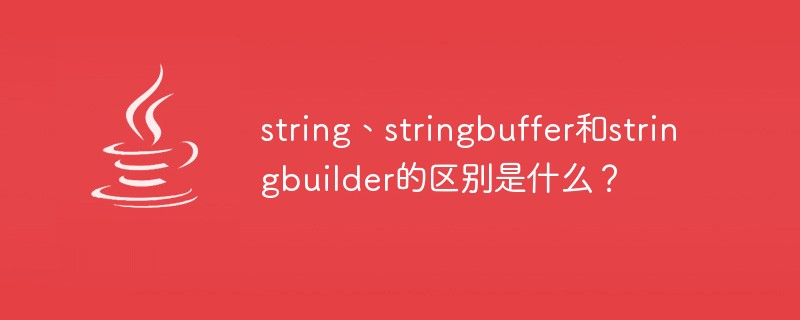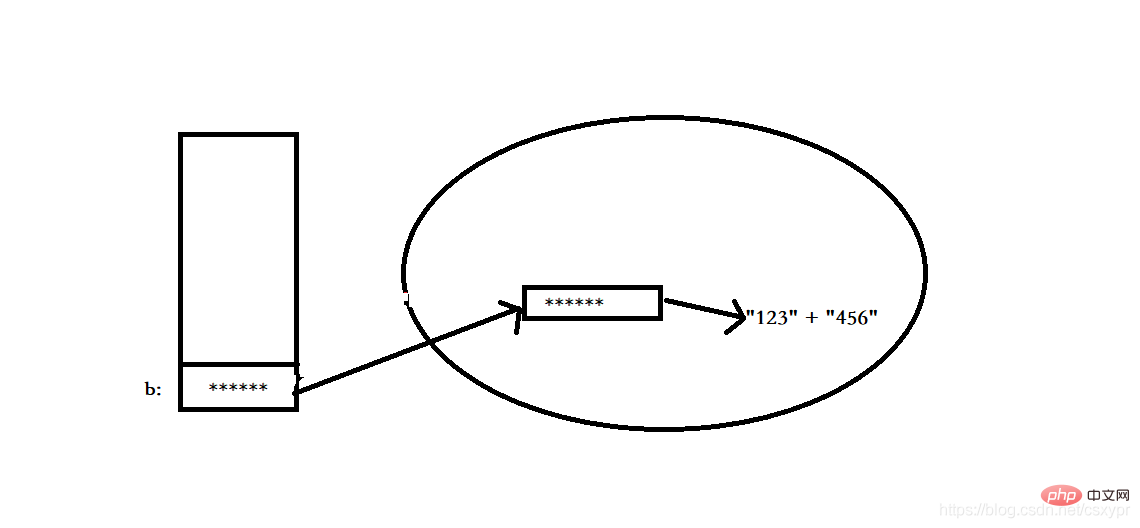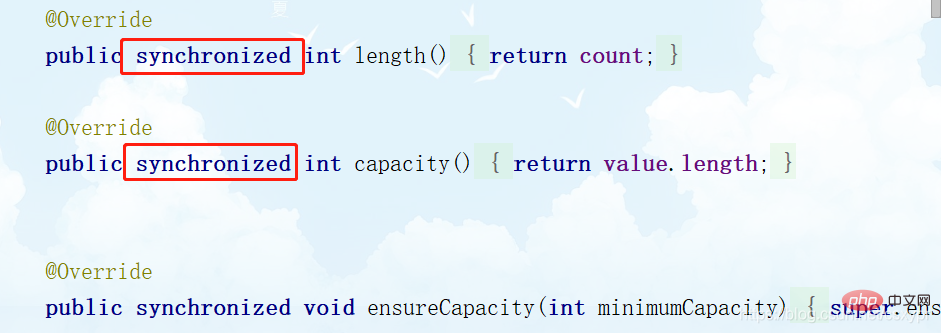What is the difference between string, stringbuffer and stringbuilder?
Nov 20, 2020 am 09:54 AMDifference: The String class is an immutable class. When a String object is created, the character sequence contained in the object is immutable until the object is destroyed; the StringBuffer object represents a mutable string object, and Thread-safe; the StringBuilder class represents mutable string objects and is not thread-safe.

##The difference between String, StringBuffer and StringBuilder:
String
The String class is an immutable class, that is, once a String object is created, the character sequence contained in the object cannot be changed until the object is destroyed. . This is an explanation of the String class. Xiao Xian'er saw this situation before and could not understand the above explanation, as followsString?a?=?"123"; a?=?"456"; //?打印出來的a為456 System.out.println(a)?Seeing this, Xiao Xian'er did not understand. This is not obvious Has it been modified? Why is it said that it is an immutable class? After learning from Xiao Xianer and his friends, we understand where the immutability of the String class is reflected. Next, let’s look at a memory storage space diagram of the above
a object
StringBuffer## The StringBuffer object represents a string with a variable character sequence. When a StringBuffer is created, the append provided by StringBuffer (), insert(), reverse(), setCharAt(), setLength() and other methods can change the character sequence of this string object. Once the final desired string is generated through the StringBuffer, you can call its toString() method to convert it into a String object.
StringBuffer?b?=?new?StringBuffer("123");
b.append("456");
//?b打印結(jié)果為:123456
System.out.println(b);
? Let’s take a look at the memory space diagram of the
b object: ? So the StringBuffer object is a string with a variable character sequence. An object is not regenerated, and new strings can be concatenated into the original object.
? So the StringBuffer object is a string with a variable character sequence. An object is not regenerated, and new strings can be concatenated into the original object.
StringBuilder The StringBuilder class also represents mutable string objects. In fact, StringBuilder and StringBuffer are basically similar, and the constructors and methods of the two classes are also basically the same. The difference is:
StringBuffer is thread-safe, while StringBuilder does not implement thread-safety functions, so the performance is slightly higher.How does StringBuffer achieve thread safety?
Methods implemented in the StringBuffer class:
 Methods implemented in the StringBuilder class:
Methods implemented in the StringBuilder class:
 ? It can be seen that the
? It can be seen that the
is added to the methods in the StringBuffer class, which means a lock is added to this method to ensure thread safety.
Improvements of Java9? Java9 has improved the implementation of strings (including String, StringBuffer, and StringBuilder). Before Java 9, strings used char[] arrays to store characters, so each character in the string occupies 2 bytes; while in Java 9, strings used byte[] arrays plus an encoding-flag field to store characters, so strings Each character occupies only 1 byte. Therefore, Java9's strings are more space-saving, and the functional methods of strings are not affected.
For more programming-related knowledge, please visit:
Introduction to ProgrammingThe above is the detailed content of What is the difference between string, stringbuffer and stringbuilder?. For more information, please follow other related articles on the PHP Chinese website!

Hot AI Tools

Undress AI Tool
Undress images for free

Undresser.AI Undress
AI-powered app for creating realistic nude photos

AI Clothes Remover
Online AI tool for removing clothes from photos.

Clothoff.io
AI clothes remover

Video Face Swap
Swap faces in any video effortlessly with our completely free AI face swap tool!

Hot Article

Hot Tools

Notepad++7.3.1
Easy-to-use and free code editor

SublimeText3 Chinese version
Chinese version, very easy to use

Zend Studio 13.0.1
Powerful PHP integrated development environment

Dreamweaver CS6
Visual web development tools

SublimeText3 Mac version
God-level code editing software (SublimeText3)
 VSCode settings.json location
Aug 01, 2025 am 06:12 AM
VSCode settings.json location
Aug 01, 2025 am 06:12 AM
The settings.json file is located in the user-level or workspace-level path and is used to customize VSCode settings. 1. User-level path: Windows is C:\Users\\AppData\Roaming\Code\User\settings.json, macOS is /Users//Library/ApplicationSupport/Code/User/settings.json, Linux is /home//.config/Code/User/settings.json; 2. Workspace-level path: .vscode/settings in the project root directory
 How to handle transactions in Java with JDBC?
Aug 02, 2025 pm 12:29 PM
How to handle transactions in Java with JDBC?
Aug 02, 2025 pm 12:29 PM
To correctly handle JDBC transactions, you must first turn off the automatic commit mode, then perform multiple operations, and finally commit or rollback according to the results; 1. Call conn.setAutoCommit(false) to start the transaction; 2. Execute multiple SQL operations, such as INSERT and UPDATE; 3. Call conn.commit() if all operations are successful, and call conn.rollback() if an exception occurs to ensure data consistency; at the same time, try-with-resources should be used to manage resources, properly handle exceptions and close connections to avoid connection leakage; in addition, it is recommended to use connection pools and set save points to achieve partial rollback, and keep transactions as short as possible to improve performance.
 python itertools combinations example
Jul 31, 2025 am 09:53 AM
python itertools combinations example
Jul 31, 2025 am 09:53 AM
itertools.combinations is used to generate all non-repetitive combinations (order irrelevant) that selects a specified number of elements from the iterable object. Its usage includes: 1. Select 2 element combinations from the list, such as ('A','B'), ('A','C'), etc., to avoid repeated order; 2. Take 3 character combinations of strings, such as "abc" and "abd", which are suitable for subsequence generation; 3. Find the combinations where the sum of two numbers is equal to the target value, such as 1 5=6, simplify the double loop logic; the difference between combinations and arrangement lies in whether the order is important, combinations regard AB and BA as the same, while permutations are regarded as different;
 Mastering Dependency Injection in Java with Spring and Guice
Aug 01, 2025 am 05:53 AM
Mastering Dependency Injection in Java with Spring and Guice
Aug 01, 2025 am 05:53 AM
DependencyInjection(DI)isadesignpatternwhereobjectsreceivedependenciesexternally,promotingloosecouplingandeasiertestingthroughconstructor,setter,orfieldinjection.2.SpringFrameworkusesannotationslike@Component,@Service,and@AutowiredwithJava-basedconfi
 python pytest fixture example
Jul 31, 2025 am 09:35 AM
python pytest fixture example
Jul 31, 2025 am 09:35 AM
fixture is a function used to provide preset environment or data for tests. 1. Use the @pytest.fixture decorator to define fixture; 2. Inject fixture in parameter form in the test function; 3. Execute setup before yield, and then teardown; 4. Control scope through scope parameters, such as function, module, etc.; 5. Place the shared fixture in conftest.py to achieve cross-file sharing, thereby improving the maintainability and reusability of tests.
 Troubleshooting Common Java `OutOfMemoryError` Scenarios
Jul 31, 2025 am 09:07 AM
Troubleshooting Common Java `OutOfMemoryError` Scenarios
Jul 31, 2025 am 09:07 AM
java.lang.OutOfMemoryError: Javaheapspace indicates insufficient heap memory, and needs to check the processing of large objects, memory leaks and heap settings, and locate and optimize the code through the heap dump analysis tool; 2. Metaspace errors are common in dynamic class generation or hot deployment due to excessive class metadata, and MaxMetaspaceSize should be restricted and class loading should be optimized; 3. Unabletocreatenewnativethread due to exhausting system thread resources, it is necessary to check the number of threads, use thread pools, and adjust the stack size; 4. GCoverheadlimitexceeded means that GC is frequent but has less recycling, and GC logs should be analyzed and optimized.
 How to work with Calendar in Java?
Aug 02, 2025 am 02:38 AM
How to work with Calendar in Java?
Aug 02, 2025 am 02:38 AM
Use classes in the java.time package to replace the old Date and Calendar classes; 2. Get the current date and time through LocalDate, LocalDateTime and LocalTime; 3. Create a specific date and time using the of() method; 4. Use the plus/minus method to immutably increase and decrease the time; 5. Use ZonedDateTime and ZoneId to process the time zone; 6. Format and parse date strings through DateTimeFormatter; 7. Use Instant to be compatible with the old date types when necessary; date processing in modern Java should give priority to using java.timeAPI, which provides clear, immutable and linear
 Advanced Spring Data JPA for Java Developers
Jul 31, 2025 am 07:54 AM
Advanced Spring Data JPA for Java Developers
Jul 31, 2025 am 07:54 AM
The core of mastering Advanced SpringDataJPA is to select the appropriate data access method based on the scenario and ensure performance and maintainability. 1. In custom query, @Query supports JPQL and native SQL, which is suitable for complex association and aggregation operations. It is recommended to use DTO or interface projection to perform type-safe mapping to avoid maintenance problems caused by using Object[]. 2. The paging operation needs to be implemented in combination with Pageable, but beware of N 1 query problems. You can preload the associated data through JOINFETCH or use projection to reduce entity loading, thereby improving performance. 3. For multi-condition dynamic queries, JpaSpecifica should be used






